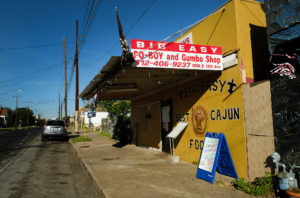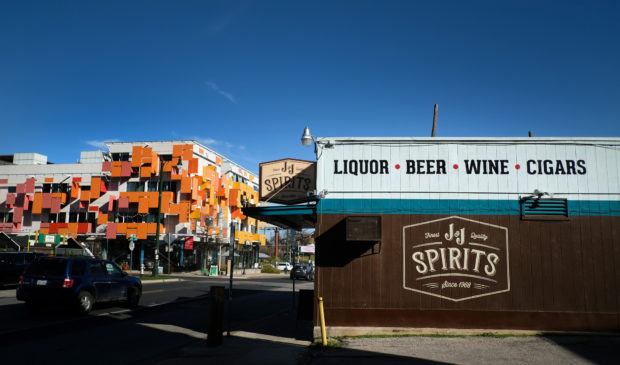On East 11th and 12th streets, two different tales of revitalization
Thursday, February 23, 2017 by
Syeda Hasan Almost two decades ago, the city of Austin launched a plan to revitalize the area around 11th and 12th streets in East Austin. Fast-forward to today, and East 11th has seen a boom of new businesses and housing, while East 12th hasn’t changed quite as much.
As part of our On My Block project, looking at the neighborhood around 12th and Chicon streets, KUT’s Syeda Hasan reports on why these two streets have seen such different results from this revitalization effort.
East 11th Street
It’s lunchtime at the Quickie Pickie on East 11th Street. Customers fill the patio tables and several others line up to order food inside. Manager Mohammad Walid describes the business as part restaurant, part convenience store.
“We’ve got tacos, and grocery, and about 400 boutique wines,” Walid said. “Also, you can eat here on the patio, sit here, relax.”

Mohammad Walid, manager of the Quickie Pickie, on 11th Street in East Austin. Gabriel Cristóver Pérez/KUT News
The Quickie Pickie has been a neighborhood fixture for about 25 years, but in the early 2000s, it came close to being demolished. Walid said the city approached his landlord about buying the property, along with the plot of land next door, to build new condos. It was all part of a broader revitalization plan for East 11th and 12th streets, which the city had officially identified as slum and blighted areas.
“The city wanted to completely buy the land off of him and revitalize the entire area, and what he chose was to sell the land for the condos, but he did not sell it for the Quickie Pickie,” Walid said.
So while the East Village condos were built next door, the Quickie Pickie remained. In 2011, the business was sold and reopened under its current management. Walid and his team expanded it from a humble drive-through convenience store to the bustling bodega it is today. He said they saw potential in the changing neighborhood along East 11th.
“The incomes have gone way up,” Walid said. “That’s one thing we noticed right off the bat. I think the diversity is still there just because some of the areas haven’t been developed, so I love that fact, but I think the houses have gone up, the incomes have gone up.”
For better or worse, East 11th seems to be the picture of urban renewal in Austin. Since the city launched its revitalization effort in 1999, the street has made significant progress toward becoming a visitor destination. Residential, retail and office development is booming. But just a few blocks away on East 12th, things are a lot quieter.
East 12th Street
Darold Gordon is the executive chef and owner of the Big Easy Bar & Grill on East 12th Street near the corner of Chicon Street. On a quiet Sunday afternoon, the restaurant’s door is propped open to beat the day’s unseasonable heat. Gordon has one full table, and a few other customers stop by to pick up to-go orders. Before the restaurant opened about two years ago, this building was a popular nightclub. Gordon often hears from customers about how much East 12th has changed, about how many of their favorite hangout spots have disappeared. As a new business owner, Gordon wants to see more investment from the city here.

12th and Chicon in East Austin. Jorge Sanhueza-Lyon/KUT News
“The neighborhood looks better, so of course the businesses will start looking better,” Gordon said. “I think the city will eventually do something special on this side to make 12th Street look like 11th Street.”
But almost two decades after the city’s plan was hatched, several plots on East 12th remain vacant or underutilized.
Two Different Fates
If we look at the number of improvements made on both streets, it’s not all that different. Not including private development, East 12th has seen nine completed projects to date, including historical preservation, and has added community parking and affordable housing. East 11th has seen 11 completed projects, along with a few others on nearby roads. So, what accounts for the difference in how these two streets look and feel? It’s hard to point to just one factor, said Sandra Harkins with the city’s Neighborhood Housing and Community Development office. Harkins said one reason is that city doesn’t own as much land on East 12th.
“The city of Austin owns several parcels already in the 11th Street corridor, so it was easier for us then to purchase the adjoining properties which created the developments that are on 11th Street, as opposed to 12th Street,” Harkins said. “Those are more privately owned.”
There’s another, less obvious challenge to building along East 12th. Much of the area’s infrastructure would require costly upgrades to support new development. In many places, the streetscape isn’t pedestrian-friendly. Utility lines hang low overhead, posing a constraint to taller development. Underground, wastewater lines are aging. A city report on the revitalization project recommended that Austin seek $10 million in public funding for infrastructure upgrades on East 12th. Harkins said that money would likely have come from bond funding, but it has yet to be placed on a ballot.
“It is still on the list, though, to be done, but it has not moved forward,” she said.
Along East 11th, the city has already revamped that infrastructure. It’s upgraded water and wastewater lines, buried utility and telephone wires. That means less cost is passed on to developers looking to build there.
Contract Dissolved
There’s yet another factor to consider in this nearly 20-year revitalization saga – bureaucratic slowdowns. When the city adopted the plan in 1999, it signed an agreement with the Urban Renewal Board and a nonprofit called the Austin Revitalization Authority, which served as the lead developer. Together, they completed several projects on East 11th, and a few on East 12th. Greg Smith is president of the Austin Revitalization Authority.
“The focus was on 11th Street initially because that’s where the majority of the land the city currently owned (was),” Smith said. “Keep in mind, there were about two or three economic downturns during that process that didn’t allow us to rapidly, if you will, move over to 12th Street.”
In 2010, the Austin Revitalization Authority’s partnership with the city was dissolved. It now operates as a private nonprofit. Smith’s office sits in the heart of the revitalization zone on East 11th, overlooking one of the ARA’s newest town home developments. As he reflected on the transformation of East 11th Street, Smith said revitalization has been a double-edged sword.
“Part of it, you want to get rid of the old stuff and make stuff brand-new, and brand-new stuff brings in new people, and it does have an impact on property tax values and things of that nature,” he said. “So you’re having to look at those various tools to make sure when you develop something, you have a mixed-income development.”
If this is any indication of what the future holds for East 12th, Smith said it will take a concerted effort to ensure that people who live there now can afford to stay.
Mohammad Walid with the Quickie Pickie said he thinks more businesses would eventually consider moving on to East 12th.
“I think the desire is there,” Walid said. “Even from us, the desire is there, but if other people are not taking steps into it, it’s hard to be the only one to take a step into it. But yeah, if the city came up with something, we’d be very interested.”
Sandra Harkins with the city said more projects are in the works on East 12th. She said the city’s Urban Renewal Board recently sold two parcels of land there to developers. Harkins anticipates we’ll see new construction in the corridor in the near future.
Top photo: Recent upscale boutiques along East 11th Street in East Austin. In the foreground is J&J Spirits, a 45-year-old liquor store. Jorge Sanhueza-Lyon/KUT News. This story was produced as part of the Austin Monitor’s reporting partnership with KUT.
The Austin Monitor’s work is made possible by donations from the community. Though our reporting covers donors from time to time, we are careful to keep business and editorial efforts separate while maintaining transparency. A complete list of donors is available here, and our code of ethics is explained here.
You're a community leader
And we’re honored you look to us for serious, in-depth news. You know a strong community needs local and dedicated watchdog reporting. We’re here for you and that won’t change. Now will you take the powerful next step and support our nonprofit news organization?









